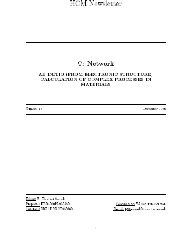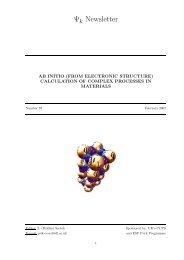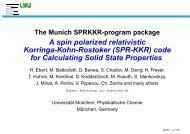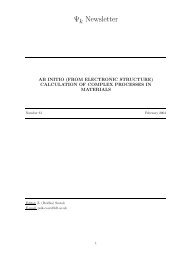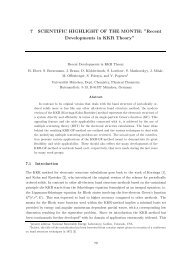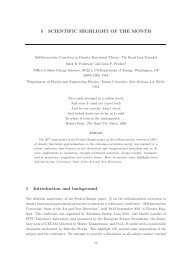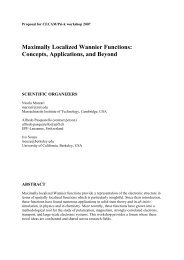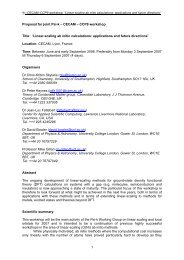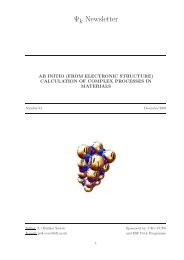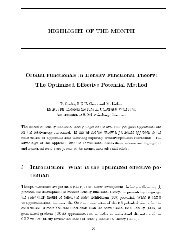Newsletter 107 - October 2011 - (pdf - 0.6 MB) - Psi-k
Newsletter 107 - October 2011 - (pdf - 0.6 MB) - Psi-k
Newsletter 107 - October 2011 - (pdf - 0.6 MB) - Psi-k
You also want an ePaper? Increase the reach of your titles
YUMPU automatically turns print PDFs into web optimized ePapers that Google loves.
density disturbance (with non-zero ensemble average) is introduced by a time-dependent<br />
external field, this can interact with disturbances elsewhere even at the (time-dependent)<br />
Hartree level. The Fluctuation Dissipation Theorem relates such interactions in the nonequilibrium<br />
driven system to the interactions between spontaneous fluctuations around<br />
the non-driven groundstate.<br />
For the dRPA case the λ integration in (5) can be carried out analytically using the<br />
following formal operator identity in (⃗r,⃗r ′ ) space: ∂ λ ln(1−λχ 0 V ) = (1 − λχ 0 V ) −1 χ 0 V =<br />
χ dRPA<br />
λ<br />
V in which products are to be interpreted as spatial convolutions:<br />
Ec dRPA = − 1 ∫ ∞<br />
∫<br />
<br />
2 0 π du d⃗r [ln(1 − V χ 0 ) + (V χ 0 )] ⃗r⃗r<br />
(7)<br />
= − ∫ ∞<br />
duTr [ln(1 − V χ 0 ) + (V χ 0 )] (8)<br />
2π<br />
= − <br />
2π<br />
0<br />
∫ ∞<br />
0<br />
duTr [ ln(1 − V 1/2 χ 0 V 1/2 ) + ( V 1/2 χ 0 V 1/2)] (9)<br />
where the properties of the trace operation have been used in the last line to introduce a<br />
hermitian operator V 1/2 χ 0 V 1/2 which is convenient especially when diagonalization methods<br />
are used to evaluate the correlation energy.<br />
While the dRPA correlation energy was calculated for the homogeneous electron gas many<br />
decades ago (see e.g. [50]), its practical evaluation in more complex systems including<br />
periodic systems is often numerically costly, and has only been carried out quite recently<br />
[51], [52], [53], [54], [55], [56], [57], [58], [59]. When used as a post-functional starting<br />
from PBE orbitals, it has proved to give a very good description of the lattice constants<br />
and elastic constants of many crystals [58] including most of the van der Waals bound<br />
rare gas crystals [60] (except He where self-interaction issues are arguably dominant - see<br />
the next Section). Atomization energies in the dRPA are good but slightly worse than<br />
those from a groundstate PBE calculation, which again may be related to self-interaction<br />
issues. Some methods have also been given to increase the numerical effiiciency of dRPA<br />
and exact exchange calculations in solids [57].<br />
For finite molecular systems the correlation energy in the dRPA and the related RPAx<br />
(see below) have been implemented in an efficient way, via methods and codes originally<br />
designed for molecular time-dependent Hartree-Fock calculations (see [55] and references<br />
therein) . On the formal side Furche [55] proved that<br />
E dRPA<br />
c = 2<br />
∑( )<br />
Ωn − Ω D n<br />
n<br />
where Ω n is an eigenfrequency of the RPA equation (6) and Ω D n is the same quantity<br />
to linear order in the Coulomb coupling strength λ. In fact the notion of using the<br />
separation-dependent part of the sum of zero point energies Ω/2 of collective modes<br />
to obtain vdW energies is quite an old one ( [1], [13]). For the macroscopic collectivemode-only<br />
models used in these old calculations one can show that this is correct (see<br />
e.g. [61]), but the Furche result is more general. For some discussion of the sum of zero<br />
49




